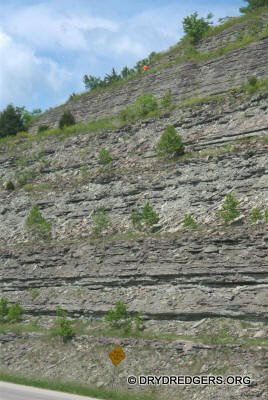

Photos by Bill Heimbrock
All specimens are to
scale with a U.S. penny, diameter 1.9 cm or 3/4 inch.
The Dry Dredgers returned to the giant road cut in
Northeastern Kentucky after having last been there in
September 2016. The site is so big, though, that we did not
collect fossils anywhere near where we collected in 2016. Our chosen section
starts with the Fairview Formation and rises into the Bellevue Formation. These
formations are of late Ordovician age - 445 million years old. In this first
picture, do you see an orange shirt near the top? That's Taylor and Bob Bross
collecting in the Bellevue Formation. Bob phoned me at the time and asked me to
take his picture, waving his hands so I could see him. He and his son Taylor
were still waving their hands when they came down from up top (second picture)
with their fossil finds for me to photograph.

Here are a few other pictures of the Dry Dredgers collecting fossils that day.
Check out the blue clay resting on this rock. This is a
complete layer of bluish shale called the "butter shale" layer. When you find
one of these layers, examine it carefully for trilobites.
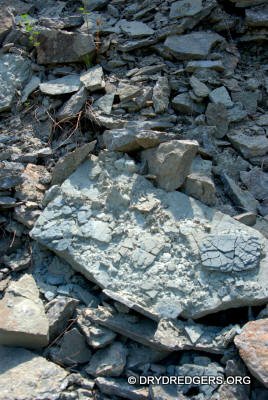
Fossils Found That Day
The big hit of the day were the trace fossils. This first
trace fossil appears to be a trilobite burrow called a Cruziana.
This trilobite seems to have gone in a circle and then continued on. We see
these confused trilobite traces every time we come here.
Click this link for one found on our
last field trip in 2016.
Here's another trilobite burrow. It's more delicate than most.
It's called a Rhusophycus.
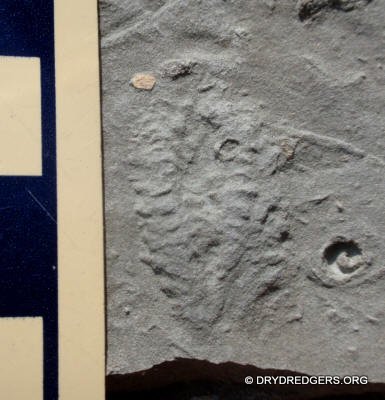
Another kind of Ichnofossil (trace fossil) found on this site
is Diplocraterion. These are sometimes called "dumbells"
and sometimes called "U-shaped" burrows. This first picture shows the top
surface of a rock with burrows that have a hole at either end (dumbells). This
is looking straight down on the burrows.
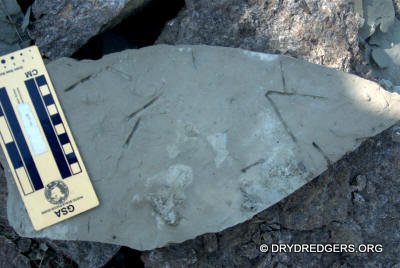
If on the other hand we split the rock so we can look down
into it vertically, we see that the burrow where the holes are goes down into
the rock and form a series of U shapes that widen near the bottom. This is also
called Diplocraterion. It's just another view of this
3-dimensional trace fossil. You can find the U-shaped burrows by looking at the
sides of any slab that have abundant dumbell traces on them.

Trilobites
No whole trilobites were found. Here is one glabella (head) of
a Flexicalymene sp.
trilobite.
...And here are some porrly preserved thorax segments of the
large trilobite Isotelus sp.
Brachiopods
There were large quantities of the small brachiopod
Cincinnetina multisecta
in some layers. These layers are often marker beds, helping paleontologists know
what layer they are examining.
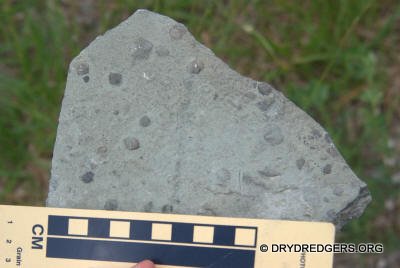
Another somewhat less common brachiopod found loose and in
rocks such as this one below is
Hebertella sp.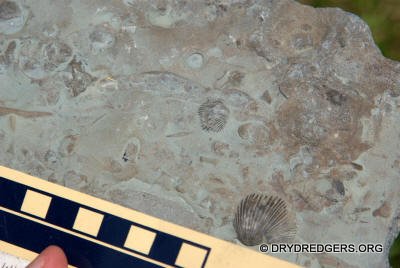
There is one particular layer in the Fairview formation
exposed on this site that has an abundance of the brachiopod
Strophomena sp.. Anywhere else
on this same site, they are much less common. The slab below is from the layer
where they are common.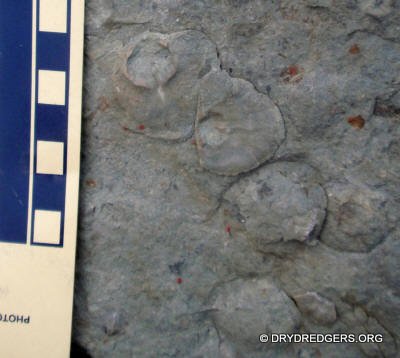
There are a few species of Vinlandostrophia found on this
site, depending on the layer. The one below is Vinlandostrophia
cypha.
Bivalves
This first fossil is a clam in which both the negative and
positive of a valve impression was found. The dark coloring may be carbon
preserving some of the shell microstructure.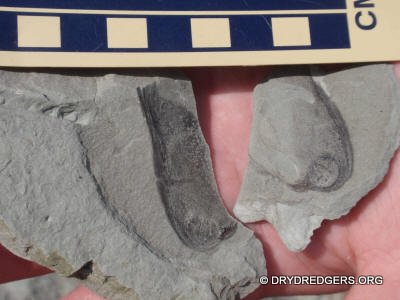
Here's another nice clam impression that has coloration that
may have preserved microstructure of the original aragonitic shell. This clam
looks like it's probably a
Modiolopsis sp.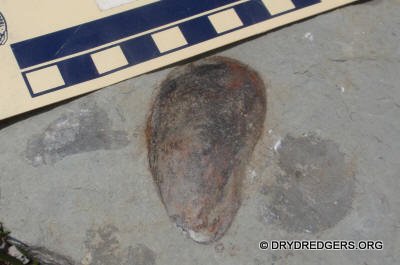
Here's an interesting clam shell that has been preserved in
brown calcite.
Gastropods (snails)
Snails from the Ordovician are usually preserved as internal
molds. In the case of the snail
Cyclonema sp,, calcite
replaced the original shell so there is actually external shell details on these
interesting gastropods. (below).
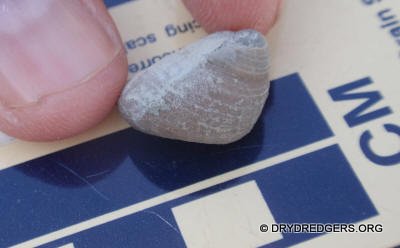
Bryozoans
The most collectable bryozoan colony found today was
Constellaria
sp. This bryozoan has monticules that are star-shaped. These are
common in the Fairview Formation of this site. Take a look at the specimen
below.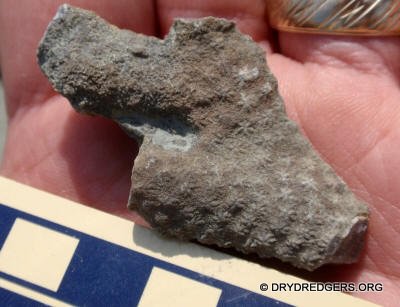
The Kope and Fairview formations have lots of massive bryozoan colonies. Most of
these are in the category we call trepostomate bryozoans. Here's one.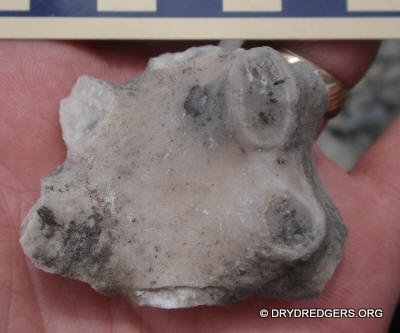
Branching ramose bryozoans formed networks of colonies on the Ordovician sea
floor, as evidenced by many of the rock slabs we saw, such as this one.
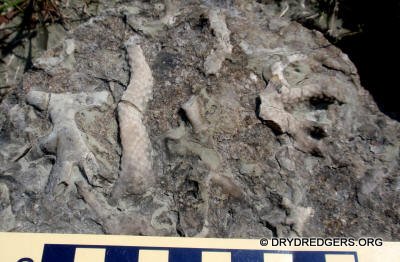
Here's a really nice assemblage of Ordovician animals found that day on a different road cut just up the street from our field trip site that a member discovered on his way. It's a brachiopod called Rafinesquina sp with some epizoans (attaching animals).
This particular epizoan is an Edrioasteroid, probably
Carneyella sp.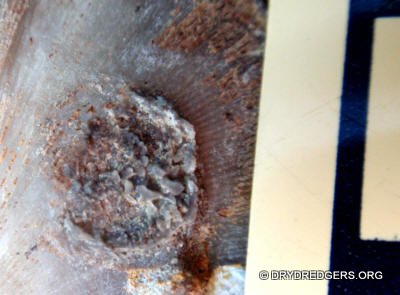
The other two epizoans are inarticulate brachiopods of an
unusual species - Schizocrania filosa.
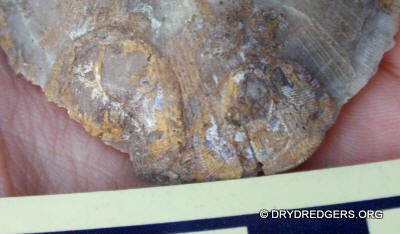
That's all for this field trip. I hope you enjoyed it. Join us in the fall for our first field trip of the season on September 28, 2019
Here are photos of our previous visits to this awesome site.
2016
2013
2012
2009
2008
September 2005
April 2005
2003
Back to the Field Trip Index Page
Return to Dry Dredgers Home Page
The Dry Dredgers and individual contributors reserve the rights
to all information, images, and content presented here. Permission to reproduce
in any fashion, must be requested in writing to
admin@drydredgers.org.
www.drydredgers.org
is designed and maintained by Bill Heimbrock.